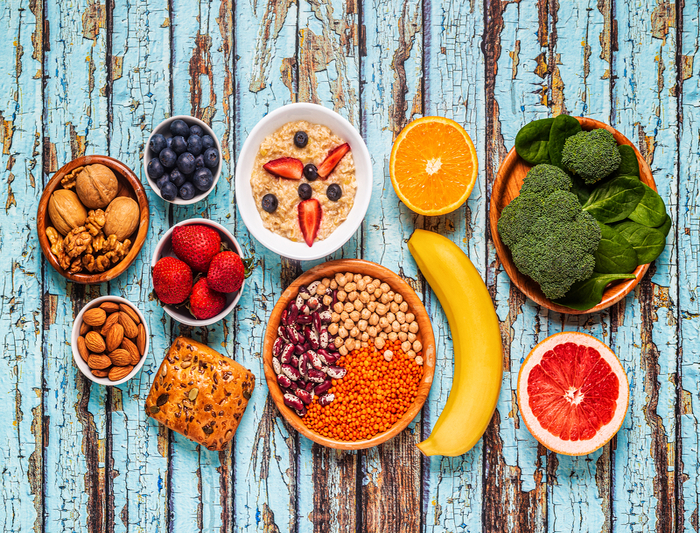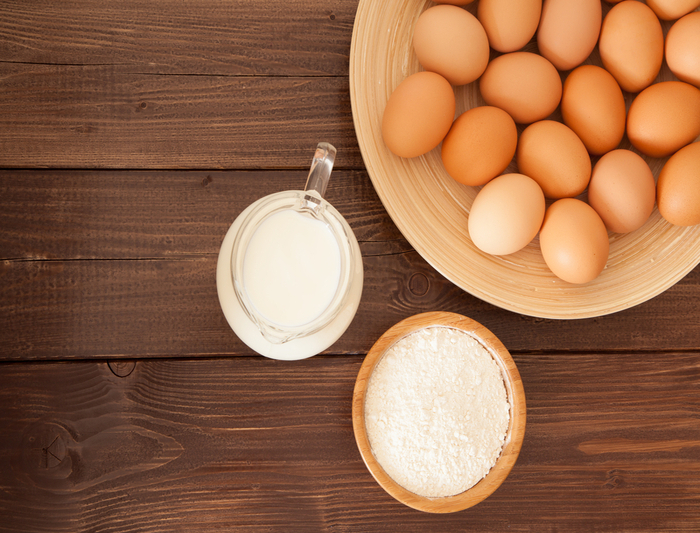- Calls to this hotline are currently being directed to Within Health or Eating Disorder Solutions
- Representatives are standing by 24/7 to help answer your questions
- All calls are confidential and HIPAA compliant
- There is no obligation or cost to call
- Eating Disorder Hope does not receive any commissions or fees dependent upon which provider you select
- Additional treatment providers are located on our directory or samhsa.gov
What Foods Make You Happy?
Depression is a common and major disease in the world [1]. In people with eating disorders, 97% of people had co-occurring conditions, most of these being major depression [2]. A co-occurring condition is when someone experiences more than one condition at a time.
It’s important for anyone with depression to find ways to improve mood. Research shows that nutrition can impact mood. For people with disordered eating, this can be especially important.
Sometimes, co-occurring disorders can feed into each other. In the example of someone with depression and an eating disorder, it’s possible that someone’s eating disorder is an attempt to cope with symptoms of depression.
However, the more they do this, the worst the depression gets because their body doesn’t have enough nutrients to support a happy mood. Nutrient-deficiencies could play a role in co-occurring depression and eating disorders.
Depression is typically treated through a combination of medication and therapy [3]. However, there are limitations to these methods. Medication for depression often comes with undesirable side effects.
These limitations have pushed researchers and clinicians to find other effective treatments for depression. Nutritional approaches have shown to be effective in boosting mood [3].
The Link Between Diet and Mood
Nutrition plays a role in the way we think and behave because it influences our memory, emotions, and ability to think [3]. There are certain chemicals in the brain that influence emotions. These are known as neurotransmitters [3].
Nutrients, or lack of, directly impact neurotransmitters [3]. Different foods affect different neurotransmitters, which can then impact different emotions. The food you eat is directly linked to how you feel [3].
All Foods Fit
It’s important to note that while there are certain foods that are associated with a lower risk of depression, it doesn’t mean that other foods are bad. It’s very common in people with eating disorders to believe that there are good and bad foods.
This can lead to restrictive diet patterns as someone tries to cut out all foods that are considered bad. A healthy diet is one that is balanced, full of variety, and includes all foods in moderation [4].
Related Reading
- Food to Eat That Makes You Feel Good
- How Your Metabolism Works
- Physical Cues of Hunger and Satiety
- Dietitian Crafted Meal Plans
- How to Regain Weight During Recovery
- Misconceptions of Healthy Eating
- Mindful Eating and Appetite Awareness
- Nutrition Care Process and Assessment
- How Your Body Uses Nutrients
- How Much Food Should I Eat?
- Shifting Body Image During BED Recovery
Foods That Boost Mood
Sarah Jackson, a registered dietitian who specializes in eating disorders and gut health, states there are certain foods that directly impact mental health in a big way [5]. According to Jackson, certain macronutrients, particularly foods containing Omega-3 fatty acids, are helpful in reducing depression [5]. Foods containing Omega-3s are [6]:
- Fish and other seafood, such as salmon, tuna, herring, and sardines
- Nuts and seeds, like flaxseed, chia seeds, and walnuts
- Plant oils, like flaxseed or soybean oil
- Eggs
- Yogurt
- Milk
The gut-brain connection is important when talking about the link between diet and mental health. Jackson says that eating whole foods that contain probiotics, can help feed the good bacteria in your digestive tract. These good bacteria can support the brain in creating and maintaining a proper balance of brain chemicals that influence mood [5]. Prebiotic foods include:
- Asparagus
- Oats
- Jerusalem artichoke
- Garlic
- Onions [5]
Mood, Emotional Eating and Binging
It’s important to note that the link between food and mood extends beyond the biological reality of nutrients, gut health, and brain chemistry. There is an emotional aspect of food that can also contribute to food making you feel happier.
Emotional eating is when you eat food as a way to cope with difficult feelings [7]. This isn’t inherently bad or unhealthy, as we all use food to soothe ourselves from time to time. However, it becomes problematic when our relationship with food is the only or main way we are dealing with our emotions.
Emotional eating can be a way of coping with depression. Symptoms of depression include [8]:
- Feeling sad, anxious, or empty
- Being irritable
- Feeling guilty, worthless, or helpless
- Loss of interest in things that used to be pleasurable
- Difficulty concentrating
- Issues with sleep, whether falling and staying asleep
- Appetite or weight changes
- Thoughts of suicide
Signs of Binge Eating
Sometimes this can turn into disordered eating. Emotional eating may turn into binge eating or binge eating disorder. Signs and symptoms of binge eating disorder include [9]:
- Fear of eating in public or with other people
- Stealing or hoarding food
- Extreme concern with body weight, shape, or size
- Recurring episodes of binge eating. A binge is when someone eats an amount of food that is larger than what most people with eat in the same amount of time
- Feeling out of control with food or feeling like they are unable to stop eating during a binge
- Guilt, shame, or disgust after overeating
- Withdrawing from friends or family
- Changes in weight
- Frequent attempts to check body shape or size, such as looking in the mirror often or checking weight on the scale
- Stomach cramps or other gastrointestinal symptoms like constipation or diarrhea
- Mood changes
Treatment for Depression and Emotional Eating
Thankfully depression and disordered eating are treatable mental conditions. If you are experiencing signs of either of these conditions, it’s important to get help. Only a qualified mental health professional, doctor, and registered dietitian are qualified to treat these conditions.
While professional support is warranted, there are coping skills that you can use in the meantime that can be helpful in coping with depression and urges to emotionally eat. These are [6]:
- Spend more time with your support system. Support from others can boost mood and provide you with help in dealing with your emotions
- Find ways to express your feelings. Some ways to get your feelings out is to journal, talk to a friend, or exercise
- Distractions. Distraction is a way to cope with urges until urges pass. If you are tempted to emotionally eat, finding things to distract yourself can help. Examples of distractions include watching TV, listening to a music, or playing a game.
If you are struggling, you can use a tool like this one to find a treatment provider in your area.
Citations
[1] Huang, Q, Liu, H., Suzuki, K., Ma, S., Liu, C. (2019). Linking what we eat to our mood: A review of diet, dietary antioxidants, and depression. Antioxidants, 8(376), 1-18. [2] National Eating Disorders Association. (n.d). Statistics and Research on Eating Disorders. Retrieved January 16th, 2022 from https://www.nationaleatingdisorders.org/statistics-research-eating-disorders [3] Yeum, T.S., Maggiolo, N.S., Gupta, C.T., Davis, B.J., Nierenberg, A.A., & Sylvia, L.G. (2019). Adjunctive nutrition therapy for depression. Psychiatric Annals, 49, 21-25. [4] Freeland-Graves, J. H., Nitzke, S., & Academy of Nutrition and Dietetics (2013). Position of the academy of nutrition and dietetics: total diet approach to healthy eating. Journal of the Academy of Nutrition and Dietetics, 113(2), 307–317. [5] S. Jackson, personal communication, January 15th, 2022. [6] National Institutes of Health. Omega-3 Fatty Acids. Retrieved January 16th, 2022 from https://ods.od.nih.gov/factsheets/Omega3FattyAcids-Consumer/ [7] Medline Plus. Break the bonds of emotional eating. National Library of Medicine. Retrieved January 16th, 2021 from https://medlineplus.gov/ency/patientinstructions/000808.htm [8] National Institute of Mental Health. Depression. Retrieved January 16th, 2021 from https://www.nimh.nih.gov/health/topics/depression [9] National Eating Disorders Association. (n.d). Binge Eating Disorder. Retrieved January 15th, 2022 from https://www.nationaleatingdisorders.org/learn/by-eating-disorder/bedAuthor: Samantha Bothwell, LMFT
Page Last Reviewed on February 7, 2022, and Updated By: Jacquelyn Ekern, MS, LPC


